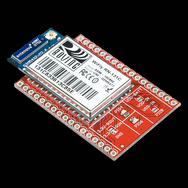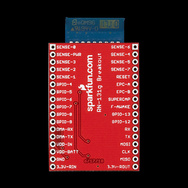Hacker spaces are cool areas where people get together to work on all kinds of projects ranging from electronics to woodworking, sculpting to sewing. It's a great way to pool resources. If you haven't ever been to a hacker space, I strongly suggest you find the nearest one and check it out. It can be an awesome source of knowledge, insight, and inspiration.

Hacker space done Denmark-style, known as Illutron
But what do you do if there is no hacker space nearby? Short of hopping on a bus or plane, the next best thing is what is known as a "virtual hacker space." Truthfully, these aren't much different than any other forum, but the focus of these virtual beacons of innovation is often just a touch more up our alley.
One such virtual hackerspace is the Cairo Hacker Space. This particular hacklab is just starting out but one cool thing they have come up with is A Beginner's Guide to Using WiFly and Arduino Via Serial.
This is a very nicely done tutorial exploring WiFly that has all the source code available for download. It's great to see these sources of knowledge springing up all over the place! Happy hacking everyone!









Lovin' the tagline "Hack like an Egyptian"
That's awesome. One top of that, they post tutorials. Free knowledge can only help the hacker space movement.
I've always wondered if Egyptians hated that song. Especially since I'm sure it's the only pose tourists are capable of doing in photos. Imagine if the song was "Walk like an American" and it was someone doing the hammer slide... okay, I take that back, I would love to see every tourist doing that.
haha, Im Egyptian...and I always get asked that question...we dont hate it, but its a stereotypical song...and Egyptians DONT walk around like 2D action figures :P Though, as an American, Id love to see every tourist doing the Hammer slide XD
Hack Like an Egyptian :D
I always thought Egyptians walked with picket signs... currenteventshumour sorry, I had to...
I do remember one individual walking in 2D action on research park... hmmm...
I've been thinking more about the whole WiFly debacle (Yes, it's a debacle. Any time you have lines of people all going to forums saying the same thing "WiFly not working!" you have a debacle.)
At some point I think a model closer to the Linux Distribution model will need to implemented, with hardware sellers maintaining their own servers from which to distribute the code that supports, among other things, their own products. Not all will opt to do this, of course, but the ones that do will be setting themselves up as "Go To Companies" for Open Source hardware implementations.
Obviously, Open Source code is released without cost or warranty of any kind, just like Linux. But I don't have to piece a Linux system from bits and pieces across the web... let's face it, I couldn't do that if I wanted too, I'm just not sufficiently knowledgeable. No, I just go to Fedora's website and download it in one shot. Fedora makes no money from me, I assume they have support licenses or something to sustain them.
I think the same model would work with Open Source hardware like the Arduino. You make your money off the parts, Then the free repository of code on the reseller's web site that is cherry picked to be applicable to what they sell, provides valuable marketing and customer loyalty.
It's just a thought.
Any "junior" hackerspaces within the Capital District? (Wait-Do they exist anywhere? I'm starting to feel really left out of the type of culture here in Albany... none of the paintings you see in the Arts Center of Troy are made with random robotic brush-strokes...)
The whole WiFly debacle confuzzles me. I really don't know what to think.
On one hand, you have one clearly superior WiFly module, the GSX. It supports both b and g modes, something the others cannot do.
And then you have 2 versions of connection mechanics... breakout only and the WiFly Shield. Both are exclusive products of SparkFun. (As far as I know, anyway.)
The cost difference is trivial, but the performance difference is not. The SPI UART on the Shield is capable of many times greater performance than the default serial options available to the breakout.
But apparently, that doesn't matter in the real world, people mostly seem to want an easy to hookup solution for transmitting trivial amounts of data wirelessly on the web, not a hardcore data pipe.
Using WiFi for this is like killing a bug with C4. But it's the only tool you got!
I've seen 2 separate systems to solve this problem with non Open Source means (You need to buy into a proprietary system) but that's like oil and water for the Arduino crowd.
As far as I can tell, (And I'm hoping SparkFun can tell me what the difference in sales volume between the breakout and the Shield is) the deciding difference is that the breakout is easier to connect to what's available in the form of libraries. Libraries that people who just want to send trivial amounts of data to a web site don't want to or can't write.
Whereas what people REALLY want is a shield that is essentially plug and play for sending small amounts of data wirelessly to the web.
What if I wanted to stream movies to my house plants/garage door opener/sprinkler system, though? I bet that the palm tree in my office would grow at least 50% faster if it got to watch Casablanca.
Wait, you shouldn't use C4 to kill bugs? But its so much fun!
Guess you could just squish them with the C4 and then still have it!
Now there's the smart money talking! Most of the fun of playing with explosives, but you STILL get your security deposit back!
Awww, but I just made some specially designed cockroach shape charges...
I have yet to play around with these. I'll be uploading a tutorial and code for using this with an AVR microcontroller, and a Cortex-m3-based microcontrolled sometime in the near future.
I designed a budget breakout board for these that only costs $3. It breaks out the basic pins (power, serial, reset, and wake).
Thats awesome gunna check that out